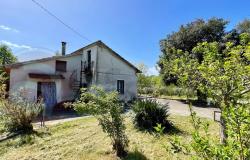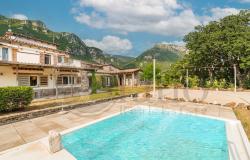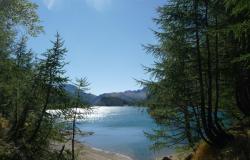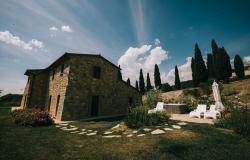Porcini mushrooms are the celebrities of Italian cuisine; widely appreciated for their rich, meaty tastes. Yet, the list of wild mushrooms that are fit for the table is surprisingly generous, although most of these edible varieties are not well known. Perhaps, it is the expertise needed to recognize these varieties, coupled with the elusive spots where they grow that makes these mushrooms difficult to find, and consequently, less appreciated. Besides, some can easily be confused with poisonous varieties, making their search the domain of expert fungaioli (mushroom hunters). One such man is Giuseppe Vanoli. Beppe, as he is known to friends, is a veteran fungaiolo from the town of Oleggio in Piedmont. I met him on the Lombard side of the river Ticino, at the riverside resort of Sesto Calende. He was willing to share some of his expert knowledge on these eclipsed, gastronomic treats of Italy.
Beppe has been studying, photographing and collecting mushrooms since childhood, and after years of wandering the woods close to home and further afield, has developed an encyclopaedic knowledge of fungi.
He is also a very active member of AMINT (Associazione Micologica Italiana Naturalistica Telematica), the Italian national association of mushroom enthusiasts whose aims are the dissemination of knowledge on fungi and the love of nature. With members from all over Italy, the association offers free consultation and identification service on 1200 types of mushrooms. Its website (http://www.amint.it/) has a searchable database with around 30000 photos of wild mushrooms.
As a fungaiolo, Beppe is driven by a very clear philosophy. ‘I don’t say I hunt for mushrooms,’ he affirms. ‘I go rambling in the woods, first and foremost, to appreciate nature.’
Mushrooms need specific conditions of temperature, humidity and forest habitat to bloom, so each variety abounds in a particular time of the year. Throughout September and October, when the temperatures start declining after the hot summer months, the hunt for mushrooms is at its peak as they start growing at low altitudes. This year, due to scant rainfall, it seems that the mushroom season in Italy shall not be very promising.
Beppe’s favourite haunt is the Mount Mottarone, the 1491-metre peak that overlooks Lake Maggiore and Lake Orta. The cooler mountain temperatures allow mushrooms to grow when it is too hot for them to thrive at lower altitudes, so he can harvest mushrooms all throughout summer. Beppe’s favourite mushrooms are commonly called Marzuoli (Hygrophorus Marzuolus). ‘According to me,’ he says, smacking his lips, ‘Marzuoli are better-tasting than Porcini. They sprout beneath pines and beeches just as the snow melts; around March.’ Marzuoli can be appreciated for their richness of taste and ‘bite’, making them a versatile ingredient in the Italian country kitchen.

On Mount Mottarone, Beppe also collects Russula mustelina. ‘These mushrooms are often mistaken for porcini,’ he says. ‘They grow very large and are often very hard. However, when put under oil they are excellent to eat – crunchy and tasty.’Beppe’s usually kind eyes harden for an instant. ‘I get angry when I find them broken or thrown away because at first sight they were mistaken for porcini. You have to respect other gatherers who could have harvested those specimens.
‘Other edible mushrooms are the Verpe and Morchelle,’ explains Beppe. ‘Verpe (genus Verpa) grow in spring and should be eaten in small amounts and with caution. Unless well cooked, they are toxic. I am not particularly fond of Morchelle (genus Morchella) or Spugnola as they are commonly known. Their appreciation and market demand, like all mushrooms, depends on individual taste and the culinary traditions of the area. For instance Morchelle fetch around €60 per kilogram in France.’

Such high prices might turn mushroom hunting into an obsession for some, whom Beppe calls "malati della ricerca" (compulsive seekers). He recounts how he recently met a group of hunters on Mount Mottarone who had been mushroom hunting before sunrise using torches. He says that such rash and dangerous enterprises frequently end badly and that often the Soccorso Alpino (Italian mountain rescue) has to intervene.
Another of Beppe’s recommended specimens is the Prugnolo or Fungo di San Giorgio (Tricholoma georgii). ‘It grows in Spring around the feast of St George – April 23rd,’ says Beppe, ‘and is an excellent edible mushroom. It has a strong taste and aroma that hints of freshly-baked bread.’ Prugnoli often form fairy rings or lightning-like zigzags which have fired the imagination and enriched the folklore of rural villages.
‘The relatives of Prugnoli, the Morette (Tricholoma terreum),’ adds Beppe, ‘are also excellent to eat. The problem is that they are very easy to confuse with highly toxic varieties.’ Of all the comestible mushrooms, Beppe considers Chiodini (Armillaria mellea), whose name was inspired by their nail-like shapes, as the most dangerous.
‘Chiodini are the primary cause of intoxication by edible fungi,’ he warns. ‘For the toxins to be destroyed, the mushrooms have to be boiled for 20 minutes, the froth removed, and the mushrooms rinsed and drained well. The stalk should also be removed as it is very hard. Chiodini are excellent fried. If the specimens have experienced a freeze during the night, they become poisonous even if cooked, so should not be collected at all. They should never be conserved frozen in the raw state as that facilitates the formation of a poison.’
Beppe’s passionate love affair with fungi spurs him to brave even the gelid winter months. ‘Flammulina velutipes is the first edible mushroom to sprout from the snow,’ he explains. ‘However, Geloni (Pleurotus ostreatus), are the best known of winter mushrooms. They are typical of poplar woods and resist freezing; very good to eat.’ He grins mischievously. ‘Nowadays, you even find Geloni-growing kits for sale, consisting of a mass of wood shavings with mycelia in them!’

A type of edible mushroom that has a decidedly macabre appellation is Trombette dei Morti (trumpets of the dead). This mushroom assumes the shape of a black trumpet but its peculiar name arose because it grows around the second of November, All Souls’ Day. ‘It is also known as Tartufo dei Poveri (truffle of the poor),’ adds Beppe, ‘and its scientific name is Craterellus cornucopioides. It is dried, powdered and used to give taste to food because it has an intense and pleasant aroma.’
Beppe’s list of edible mushrooms is exhaustive – Russula vesca, Russula virescens, Cortinarius peastans, Cortinarius caperatus, Cantarellus cibarius, Cantarellus cinereus, all the genus Lecinum and Xerocomus badius, all of which grow mostly throughout September and October. He seems to know the whims and quirks of each specimen as if they were relatives or friends.
Beppe advises any would be mushroom enthusiast to be a lover of nature first. ‘Searching for mushrooms is really a way of getting into contact with and being grateful to nature; accepting her gifts. It is the appreciation of silence in the woods; the respect for the environment.’
Beppe believes that the success of some individuals in harvesting elusive wild mushrooms is a result of their lifelong search for knowledge through reading and observation of nature’s patterns during excursions in the woods. ‘Good fungaioli,’ he says, ‘are able to identify specific plants which favour the growth of specific fungi. A good memory is enhanced by practice and experience.’
It is people like Beppe, whose passionate interest in mushrooms compels them to wander the woods of Italy in rain or shine, that allow us to sample nature’s bounty at its best and who have contributed to keep alive the ancient tradition of the fungaiolo. The harvest of countless Italian fungaioli throughout the centuries, often poor people in search of a dietary boost for their families, has certainly been a contributing factor to the placement of Italian cuisine amongst the most celebrated in the world.













